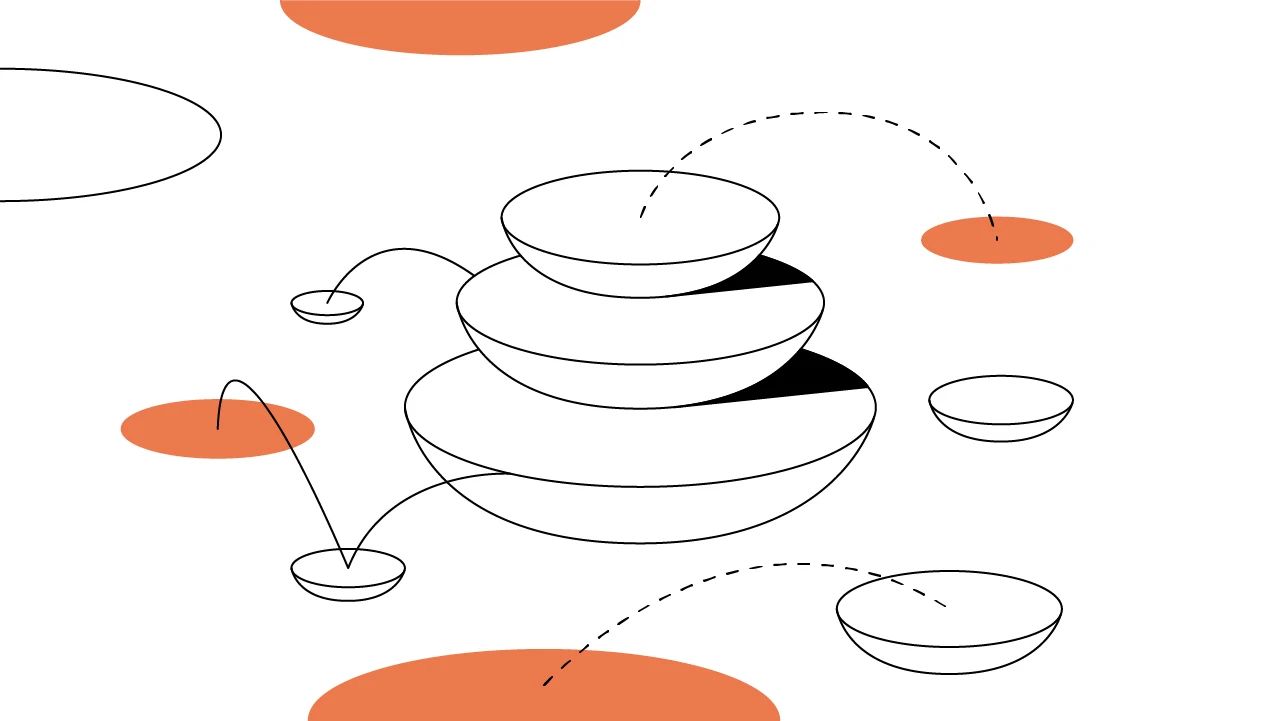Contents
How Bancor (BNT) Solves Impermanent Loss in DeFi
Bancor’s latest version, Bancor v2.1, offers several key features to liquidity providers (LPs), including single-sided exposure and impermanent loss protection.
By Eyal Herzog, Co-Founder & Chief Product Architect, Bancor
Updated October 16, 2023 • 3 min read

Summary
Bancor deployed the first-ever automated market makers (AMMs) on Ethereum in 2017, before “DeFi” was a thing. Despite Uniswap’s subsequent success and the rise of similar competitors such as SushiSwap, Bancor persisted in iterating on its original product. Bancor’s latest version, Bancor v2.1, offers several key features to liquidity providers (LPs), including single-sided exposure and impermanent loss protection. These features are designed to generate higher, more reliable yields from trading fees and liquidity mining rewards.
A Brief History of AMM Liquidity Pools
Asset exchanges have historically relied on the traditional order-book-style matching of submitted bids and asks to execute trades. In 2017, Bancor exchange removed order books entirely — and instead introduced a network of on-chain liquidity pools to pair pools of tokens with one another. Users can trade against these pooled token pairs, with prices set algorithmically based on both the size of the user’s trade and the depth of the corresponding token pools.
This novel approach to market making proved to be a paradigm shift within the decentralized exchange (DEX) space. Traders now have guaranteed access to on-chain liquidity with transparent, upfront pricing, doing away with the need for a counterparty. Token owners can also turn existing holdings into productive assets through liquidity provision to these DEX pools, earning returns from protocol swap fees imposed on trades that get routed through the platform.
This has turned pooled market-maker liquidity into a new asset class (“liquidity positions”), allowing for broader, more competitive involvement in market making.
However, first-generation automated market makers (AMMs) tend to suffer from two core issues faced by liquidity providers (LPs):
Involuntary Token Exposure: LPs must be exposed to the price movements of multiple tokens in a pool, thereby losing their long positions on their favorite tokens.
Impermanent Loss: LPs are subject to value loss when the prices of pool assets diverge, causing them to under-perform a basic buy-and-hold strategy.
Bancor v2.1 offers a solution to both issues through novel mechanisms called Single-Sided Liquidity and Impermanent Loss Protection, powered by Bancor’s BNT token.
Bancor Exchange’s Single-Sided Liquidity
A user may provide liquidity to a Bancor pool with a single token and maintain 100% exposure to the token. In contrast, other AMMs require LPs to take on exposure to multiple assets. With single-sided liquidity, LPs can stay long on a single asset and collect “HODL” returns, while earning swap fees and mining rewards.
Swap fees auto-compound in the pool and are paid in the tokens staked, while rewards (discussed below) may be manually re-staked to the protocol in a single-sided fashion to compound yield.
How It Works:
Provide liquidity to a pool in the risk asset (e.g., ETH, WBTC, LINK) or in the Bancor Network Token (BNT).
To support single-sided, non-BNT deposits, the protocol co-invests BNT in its pools to match user deposits. For example, a user deposit of $100,000 USD in LINK triggers $100,000 of BNT token emissions by the protocol into the LINK pool.
Protocol-invested BNT generally remains in the pool earning fees until the associated stake (i.e., user-deposited LINK) is withdrawn, at which point the protocol burns the BNT it had invested and its accumulated fees.
Protocol-invested BNT may also be burned if a BNT token holder provides their BNT to the pool. In this case, the user-deposited BNT takes over the protocol’s position in the pool, burning an equal value of protocol-invested BNT.
Bancor Network’s Impermanent Loss Protection
Impermanent loss (IL) occurs in AMM pools when the prices of the tokens in a pool diverge in any direction. The more divergence, the greater the IL, reducing an LP’s profits from swap fees and rewards.
Bancor v2.1 removes IL risk for LPs and transfers it to the Bancor exchange protocol, which aggregates and backstops IL risk across its pools. The protocol uses fees earned from its co-investments of BNT in pools to compensate for the network-wide cost of IL. While some pools may have high IL and low fees, others may have low IL and high fees. If there aren’t enough fees to fully compensate an LP’s IL at the time of their withdrawal, the protocol mints BNT to cover the delta.
How It Works:
When a user makes a new deposit, the cover offered by their insurance policy increases at a rate of 1% each day the stake remains live, and matures to full coverage after 100 days.
After this period, any impermanent loss that occurred in the first 100 days — or any time thereafter — is covered by the protocol at the time of withdrawal.
Withdrawals prior to the 100-day maturity are only eligible for partial IL compensation. For example, withdrawals after 60 days in the pool receive 60% compensation on any impermanent loss incurred.
There is no IL compensation offered for stakes withdrawn within the first 30 days; the LP is subject to the same IL they would have incurred in a standard AMM.
This means that even if a token moons in price, an LP is entitled to withdraw the full value of their tokens as if they held them in their wallet, so long as the LP has accrued full protection over the 100 day period. For example, if an LP stakes 1 ETH and the ETH price doubles, the LP can still withdraw at least the equivalent value of 1 ETH back, plus fees and rewards, after the staking period.
Liquidity Mining Rewards
Pools may be selected by the BancorDAO for the BNT liquidity mining program. Current pools in the BNT token liquidity mining program include: ETH, WBTC, LINK, USDC, DAI, USDT, SNX, AAVE, UNI, GRT, ALPHA, ENJ, ROOK, MATIC, wNXM.
How It Works:
Each selected pool receives a fixed emission of minted BNT tokens, which are shared by the pool’s LPs.
Pools are initially voted into the program for a minimum of 12 weeks of rewards, after which the decentralized autonomous organization (DAO) may vote to extend rewards on a pool every 30 days.
LPs may re-stake their rewards single-sided to the same or different pools to compound their yield.
Bancor Network: Liquidity For the People, By the People
AMMs are revolutionary because they allow liquidity to flow from everyday users. Yet risks like involuntary token exposure and impermanent loss threaten access to AMMs for retail token holders. If users are expected to constantly monitor and act on changes in the AMM to avoid losses, liquidity provision becomes a game reserved for professional market makers.
Since its launch, Bancor v2.1 has been adopted by a broad range of liquidity providers who not only include retail token holders, but also large funds and institutions seeking passive, high-yield returns on assets they're long on — without the complexities that AMMs have presented to date. Financial systems are only as decentralized as their liquidity sources. To build censorship-resistant, inclusive liquidity infrastructure, Bancor aims to maintain level playing fields for LPs to power the ever-growing DeFi ecosystem.
Cryptopedia does not guarantee the reliability of the Site content and shall not be held liable for any errors, omissions, or inaccuracies. The opinions and views expressed in any Cryptopedia article are solely those of the author(s) and do not reflect the opinions of Gemini or its management. The information provided on the Site is for informational purposes only, and it does not constitute an endorsement of any of the products and services discussed or investment, financial, or trading advice. A qualified professional should be consulted prior to making financial decisions. Please visit our Cryptopedia Site Policy to learn more.

Author
Eyal Herzog
Co-Founder & Chief Product Architect, Bancor
Eyal Herzog is a Co-Founder and the Chief Product Architect of the Bancor Protocol, the Bancor Network Token (BNT), and the suite of end-user products that utilize it. Eyal has been a venture-backed technology entrepreneur for over 20 years, and was the Founder of MetaCafe, Israel's fastest growing video sharing site. Eyal began his career in the technology industry in the Israeli military, where he served four years as an IT department manager for the Intelligence Core (8200) and was responsible for the IDF’s first computer networking projects. After leaving the army in 1997, he joined serial networking startup Class Data Systems as an application marketing engineer. The company was later sold to Cisco for $50 million, and Eyal invested his windfall into his first startup, Contact Networks, one of the first online social networks, after which he founded MetaCafe to address the emerging long-tail of user-generated content in the nascent online video space.
Is this article helpful?


